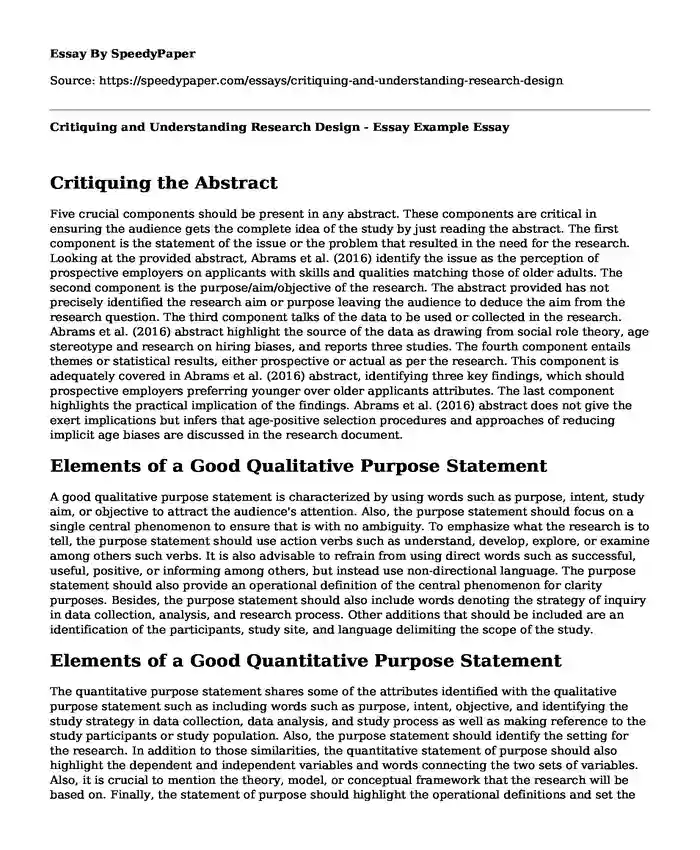
| Type of paper: | Essay |
| Categories: | Research |
| Pages: | 3 |
| Wordcount: | 682 words |
Critiquing the Abstract
Five crucial components should be present in any abstract. These components are critical in ensuring the audience gets the complete idea of the study by just reading the abstract. The first component is the statement of the issue or the problem that resulted in the need for the research. Looking at the provided abstract, Abrams et al. (2016) identify the issue as the perception of prospective employers on applicants with skills and qualities matching those of older adults. The second component is the purpose/aim/objective of the research. The abstract provided has not precisely identified the research aim or purpose leaving the audience to deduce the aim from the research question. The third component talks of the data to be used or collected in the research. Abrams et al. (2016) abstract highlight the source of the data as drawing from social role theory, age stereotype and research on hiring biases, and reports three studies. The fourth component entails themes or statistical results, either prospective or actual as per the research. This component is adequately covered in Abrams et al. (2016) abstract, identifying three key findings, which should prospective employers preferring younger over older applicants attributes. The last component highlights the practical implication of the findings. Abrams et al. (2016) abstract does not give the exert implications but infers that age-positive selection procedures and approaches of reducing implicit age biases are discussed in the research document.
Elements of a Good Qualitative Purpose Statement
A good qualitative purpose statement is characterized by using words such as purpose, intent, study aim, or objective to attract the audience's attention. Also, the purpose statement should focus on a single central phenomenon to ensure that is with no ambiguity. To emphasize what the research is to tell, the purpose statement should use action verbs such as understand, develop, explore, or examine among others such verbs. It is also advisable to refrain from using direct words such as successful, useful, positive, or informing among others, but instead use non-directional language. The purpose statement should also provide an operational definition of the central phenomenon for clarity purposes. Besides, the purpose statement should also include words denoting the strategy of inquiry in data collection, analysis, and research process. Other additions that should be included are an identification of the participants, study site, and language delimiting the scope of the study.
Elements of a Good Quantitative Purpose Statement
The quantitative purpose statement shares some of the attributes identified with the qualitative purpose statement such as including words such as purpose, intent, objective, and identifying the study strategy in data collection, data analysis, and study process as well as making reference to the study participants or study population. Also, the purpose statement should identify the setting for the research. In addition to those similarities, the quantitative statement of purpose should also highlight the dependent and independent variables and words connecting the two sets of variables. Also, it is crucial to mention the theory, model, or conceptual framework that the research will be based on. Finally, the statement of purpose should highlight the operational definitions and set the scope of the research.
The rationale for Using Mixed Method
A mixed-method approach is often preferred when one intends to provide a more detailed explanation of the findings by describing the quantitative data using qualitative findings or comparing quantitative with qualitative data, or developing a new measurement instrument. Combining both qualitative and quantitative approaches ensures that both statistical and qualifying data are reported for a better understanding of the issue under investigation.
How Research Questions/Hypothesis work in Conjunction with Purpose Statement
The research questions or hypotheses when used together singly in a study have a direct connection with the study purpose statement. The research question with the hypotheses should be addressing the purpose statement or frame in a way to help the researcher address the purpose statement. Therefore, issues identified in the purpose stamen should be captured in the research questions and/or the hypotheses.
References
Creswell, J.W. & Creswell, J.D. (2018). Research design: qualitative, quantitative, and mixed methods approach (5th Ed. ). SAGE Publishing
Cite this page
Critiquing and Understanding Research Design - Essay Example. (2024, Jan 15). Retrieved from https://speedypaper.com/essays/critiquing-and-understanding-research-design
Request Removal
If you are the original author of this essay and no longer wish to have it published on the SpeedyPaper website, please click below to request its removal:
- Research Proposal Example in Psychology - Free Essay for Studentd
- Bison Transport Research - Free Essay on the Canadian Transportation Company
- Free Essay Example on the Microsoft Bond Issue
- Essay Example: Human Development Report
- Pharmacy Loyalty Paper Sample
- Free Paper: Motivation for Research and Job Satisfaction of the University Staff: Are They Interconnected?
- Chapter Summary and Analysis Essay: Sustainable Practices in Land Transportation
Popular categories




